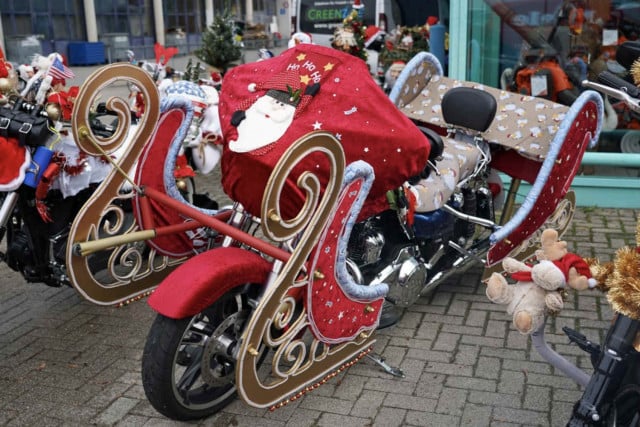Flanked by at least 50 of his similarly-dressed colleagues, Santa Claus rides into town in early December, headed directly for the Basel Marktplatz.
Once there, the world’s most approachable biker gang makes a swift determination as to who’s been naughty and nice before handing out presents, snacks and sweets to the local children.

Image: Harley Owners Group Switzerland
The Harley-riding Santas are members of the Northwest Chapter of the Harley Owners Group – conveniently known as HOG – an organisation with over one million members worldwide who harness biking enthusiasm for good causes.
The event, known as the Harley Niggi-Näggi, has been running in Basel since 1999.
While at this stage it is less of an age-old tradition as some others, it has established itself as a central event on the Basel Christmas calendar.
The event calls for donations and raises money for the Theodora Foundation, a charity which helps fund entertainment and activities for sick children in hospital.

Image: Harley Owners Group Switzerland
This includes clowns – known as Giggle Doctors – which visit hospitals with music and props to entertain sick and disabled children.
The Foundation also run the Little Orchestra for the Senses – which brings singing, dancing and music performance to disabled children in hospital.
In 2019, the HOG raised CHF40,000 for the Theodora Foundation.
Money is raised through sponsorship from local businesses and organisations, as well as private donations. Anyone who wants to donate or take part can do so at the following link.

Santa in Basel – simultaneously naughty and nice. Image: Harley Owners Group Switzerland
For anyone who’s keen to check it out, unfortunately it’s already been run and done for 2019 – with the event taking place on December 7th as part of Nikolaus Day celebrations.
Next year’s event has already been scheduled though, with Santa set to ride into town on Saturday December 5th – handing out presents at 5pm in the market square.
Swiss Christmas Traditions
Bizarre Swiss Christmas traditions #2: The Harley riding Santas of Basel
Bizarre Swiss Christmas traditions #3: Get drunk on cake, but don’t “make it vomit”
Bizarre Swiss Christmas Traditions #4: Lake Lucerne’s Santa Hunt
Bizarre Swiss Christmas Traditions #5: Edible gingerbread trees
Bizarre Swiss Christmas traditions: #6 Geneva's 'Coupe de Noël'
p.p1 {margin: 0.0px 0.0px 0.0px 0.0px; line-height: 14.0px; font: 12.0px Helvetica}
p.p2 {margin: 0.0px 0.0px 0.0px 0.0px; line-height: 14.0px; font: 12.0px Helvetica; min-height: 14.0px}
p.p3 {margin: 0.0px 0.0px 0.0px 0.0px; line-height: 14.0px; font: 12.0px Times; color: #0000e9; -webkit-text-stroke: #0000e9}
span.s1 {text-decoration: underline ; font-kerning: none}



 Please whitelist us to continue reading.
Please whitelist us to continue reading.
Member comments